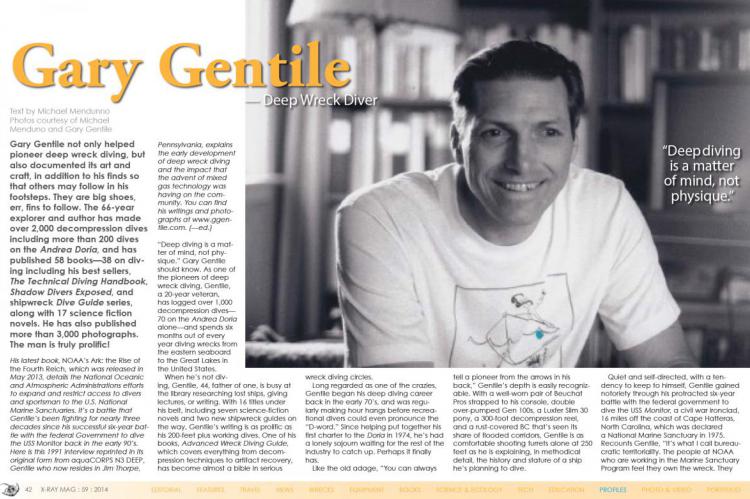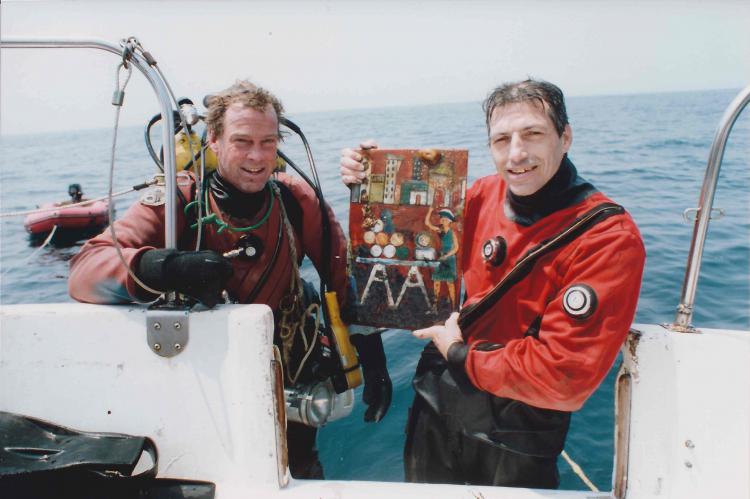Gary Gentile —Deep Wreck Diver
Gary Gentile not only helped pioneer deep wreck diving, but also documented its art and craft, in addition to his finds so that others may follow in his footsteps.
They are big shoes, err, fins to follow. The 66-year explorer and author has made over 2,000 decompression dives including more than 200 dives on the Andrea Doria, and has published 58 books—38 on diving including his best sellers, The Technical Diving Handbook, Shadow Divers Exposed, and shipwreck Dive Guide series, along with 17 science fiction novels. He has also published more than 3,000 photographs. The man is truly prolific!
Tags & Taxonomy
His latest book, NOAA’s Ark: the Rise of the Fourth Reich, which was released in May 2013, details the National Oceanic and Atmospheric Administrations efforts to expand and restrict access to divers and sportsman to the U.S. National Marine Sanctuaries. It’s a battle that Gentile’s been fighting for nearly three decades since his successful six-year battle with the federal Government to dive the USS Monitor back in the early 90’s.
Here is this 1991 interview reprinted in its original form from aquaCORPS N3 DEEP, Gentile who now resides in Jim Thorpe, Pennsylvania, explains the early development of deep wreck diving and the impact that the advent of mixed gas technology was having on the community. You can find his writings and photographs at www.ggentile.com. (—ed.)
“Deep diving is a matter of mind, not physique.” Gary Gentile should know. As one of the pioneers of deep wreck diving, Gentile, a 20-year veteran, has logged over 1,000 decompression dives—70 on the Andrea Doria alone—and spends six months out of every year diving wrecks from the eastern seaboard to the Great Lakes in the United States.
When he’s not diving, Gentile, 44, father of one, is busy at the library researching lost ships, giving lectures, or writing. With 16 titles under his belt, including seven science-fiction novels and two new shipwreck guides on the way, Gentile’s writing is as prolific as his 200-feet plus working dives. One of his books, Advanced Wreck Diving Guide, which covers everything from decompression techniques to artifact recovery, has become almost a bible in serious wreck diving circles.
Long regarded as one of the crazies, Gentile began his deep diving career back in the early 70’s, and was regularly making hour hangs before recreational divers could even pronounce the “D-word.” Since helping put together his first charter to the Doria in 1974, he’s had a lonely sojourn waiting for the rest of the industry to catch up. Perhaps it finally has.
Like the old adage, “You can always tell a pioneer from the arrows in his back,” Gentile’s depth is easily recognizable. With a well-worn pair of Beuchat Pros strapped to his console, double over-pumped Gen 100s, a Luxfer Slim 30 pony, a 300-foot decompression reel, and a rust-covered BC that’s seen its share of flooded corridors, Gentile is as comfortable shooting turrets alone at 250 feet as he is explaining, in methodical detail, the history and stature of a ship he’s planning to dive.
Quiet and self-directed, with a tendency to keep to himself, Gentile gained notoriety through his protracted six-year battle with the federal government to dive the USS Monitor, a civil war ironclad, 16 miles off the coast of Cape Hatteras, North Carolina, which was declared a National Marine Sanctuary in 1975. Recounts Gentile, “It’s what I call bureaucratic territoriality. The people at NOAA who are working in the Marine Sanctuary Program feel they own the wreck. They don’t want private sector encroachment. They look upon it as their wreck, and they view me—the public—as a trespasser.”
But the Monitor battle was more than a struggle for the diving public’s right of access; it became a struggle for the recognition of technical diving as well. NOAA refused the 11 permit applications filed by Gentile and others on the grounds that diving the wreck, which lies in 220 feet of water, was too dangerous using ordinary scuba, placing it beyond the limits of sport diving.
Gentile’s court victory earlier this year and long-awaited permit to dive the Monitor was a professional and personal vindication. The verdict? NOAA’s standards were deemed antiquated and failed to account for advances in diving technology and techniques. Furthermore, the court found that Gentile and his colleagues were wrongly and improperly classified as recreational divers.
Interestingly enough, Gentile’s July victory dives on the Monitor were conducted as practice runs for a deep dive on the Ostfriesland, a German battleship lying in 380 feet of water, which he and his diving partner, Ken Clayton, successfully conducted on mix a month later.
His motivation? “It’s about freedom,” explains Gentile, “a battle I’ve been fighting all my life. There will always be people who’ll tell you, ‘You shouldn’t be doing this. It’s dangerous. It can’t be done.’ That’s their problem. I just want to live my life the way I want to and for me, that’s what these dives are all about.”
aquaCORPS: Gary, you’ve been on the cutting edge of wreck diving for 20 years and you were one of the first people to dive the Andrea Doria back in 1974. Did you take a lot of heat for your diving back then?
Gary Gentile: My entire diving career, the local people—the people in dive clubs—looked at me as a madman. I’ve gotten back on the boat many times only to have people say to me, “What were you doing down there? Why were you just hanging on the anchor line?”
People didn’t know anything about decompression dives. And those who did didn’t approve because I was doing long decompressions. It wasn’t that I liked decompression diving; it was that I wanted more bottom time. I was willing to sacrifice for it.
How did you get trained in decompression?
I had the good fortune of falling in with a small group of divers who were doing deep decompression dives. At the time, deep was considered 160, 170 feet. That was the group I first dove the Doria with back in ‘74, and we took a lot of flak for it. People looked at us as crazies because we were doing dives no one else would do.
That’s how I picked up most of my early experience in the water—the things I wasn’t taught in courses. I studied their techniques and developed my own, just like everybody else does. Wreck diving tends to be an evolving sport; everybody who gets into it looks at what other people are doing and adds his own little improvements. I got into that as well. I was really fortunate to get in with a group of expert divers ...
(...)
Download the full article ⬇︎

Originally published
X-Ray Mag #59
South Africa's Sardine Run & Cage Diving; Honduras' Miskito Cays; Mars the Magnificent 16th century wreck in Sweden; Richard Lundgren interview; Washington State's Hood Canal; Namibian Sinkholes; Gary Gentile profile; Ghost Fishing; Basking Sharks; Wide-Angle with Mirrorless Cameras; Scuba Confidential on Breaking the Chain; Tech Talk: Listerners, Watchers and Doers; Michael Frank portfolio; Plus news and discoveries, equipment and training news, books and media, underwater photo and video equipment, turtle news, shark tales, whale tales and much more...






























